
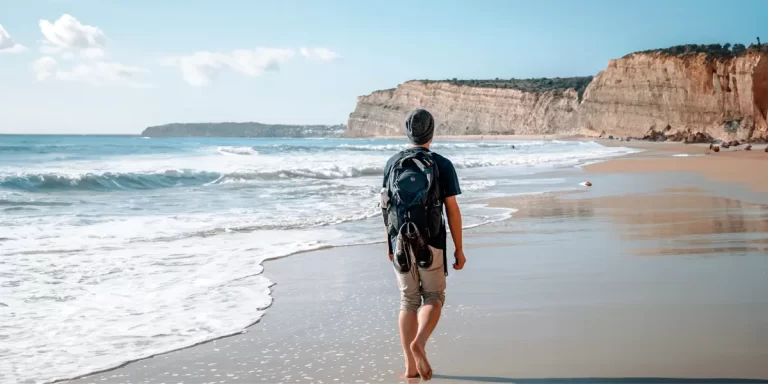
Backpacking in Portugal offers immense variety for outdoor enthusiasts, from the rugged hills of the Serra da Estrela to the windswept coastal paths of the Algarve, including popular destinations like the Douro Valley wine region.
And that’s what this post is all about – backpacking in Portugal. We’ll provide tips to help you prepare for backpacking in this diverse country as well as showcase the TOP 5 multi-day trails in Portugal.
Interested? Let’s get started.
Explore Portugal’s best scenic long trails for epic adventures with diverse wildlife:

Length: 169.3 mi / 272.5 km
Type: Point to point
Difficulty: Hard
Elevation Gain: 17 007 ft / 5184 m
Location: Porto
Estimated Hiking Calorie Burn: 36 000 calories
More Details: See on AllTrails
Trek the stunning 169-mile Portuguese Coastal Way from Porto to Santiago de Compostela. This challenging route takes about 65 hours to complete and is open year-round. Expect beautiful coastal views, historic villages, forests, beaches, and rivers along the way. Encounter fellow pilgrims on this popular alternative Camino de Santiago route. Careful planning is essential for the terrain and longer coastal stages. The rewarding journey and peaceful seaside offer a perfect Camino experience.
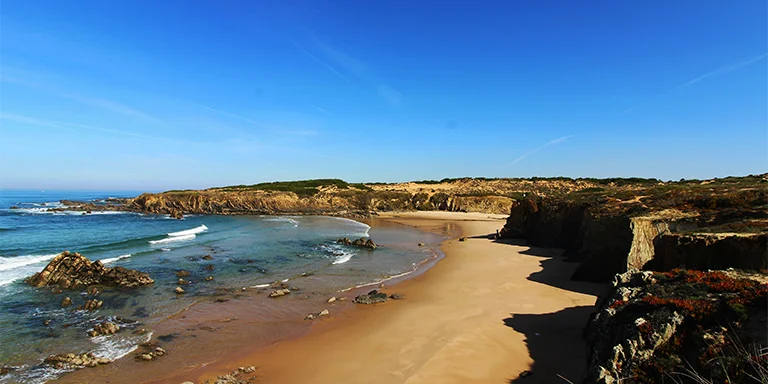
Length: 45.9 mi / 73.9 km
Type: Point to point
Difficulty: Moderate
Elevation Gain: 3950 ft / 1204 m
Location: Parque Natural do Sudoeste Alentejano e Costa Vicentina
Estimated Hiking Calorie Burn: 3200 calories
More Details: See on AllTrails
Hike the scenic 45.9-mile coastal trail from Vila Nova de Milfontes along Portugal’s southwestern shore. This moderately challenging route takes around 17 hours to complete. Enjoy ocean vistas, coastal villages, and sandy beaches on this popular trail perfect for backpacking, hiking, and biking. The mild weather from September to June provides ideal conditions. Plan for sun exposure and bring plenty of water as shade is minimal. While the terrain is relatively flat, the soft sand makes for a leg workout. With proper preparation, savor the natural beauty and solitude found along this peaceful seaside trail.
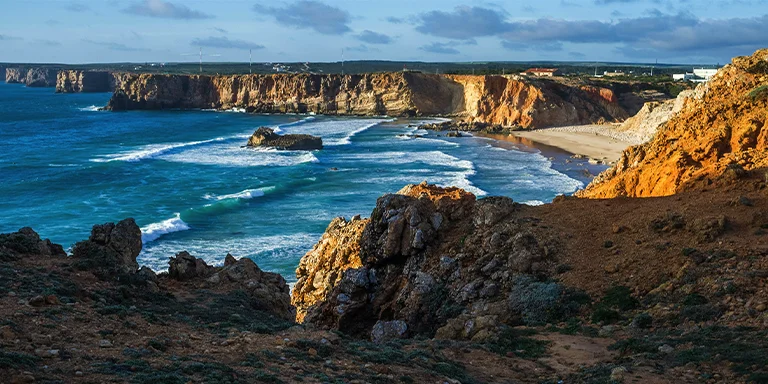
Length: 137.4 mi / 221.1 km
Type: Point to point
Difficulty: Moderate
Elevation Gain: 13 136 ft / 4004 m
Location: Parque Natural do Sudoeste Alentejano e Costa Vicentina
Estimated Hiking Calorie Burn: 23 500 calories
More Details: See on AllTrails
Trek the scenic 137.4-mile Rota Vicentina route along Portugal’s picturesque southwestern coast. This moderately challenging trail takes approximately 53 hours to complete. The route is open year-round and offers stunning coastal vistas as it passes through the Alentejo and Algarve regions. Expect to encounter white sand beaches, imposing cliffs, flowering fields, and lush forests. While most sections are suitable for hikers of all skill levels, some feature steep climbs and descents. The trail is well marked and can be done in sections over multiple days.
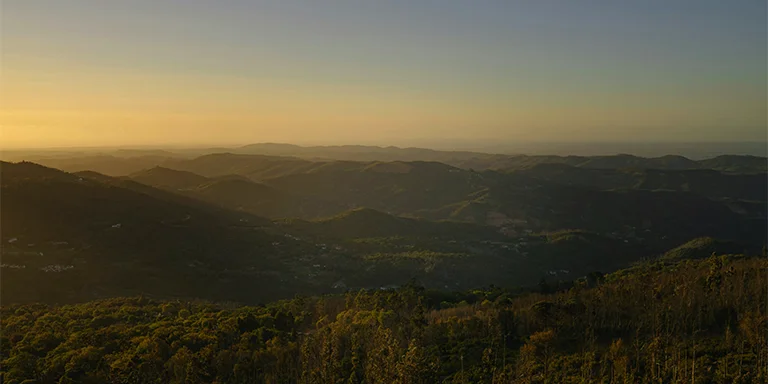
Length: 189.1 mi / 304.3 km
Type: Point to point
Difficulty: Hard
Elevation Gain: 26 108 ft / 7958 m
Location: Alcoutim
Estimated Hiking Calorie Burn: 60 400 calories
More Details: See on AllTrails
Hike the challenging 189-mile Via Algarviana from Alcoutim to Cabo de São Vicente along Portugal’s southern coast. This stunning point-to-point trail takes approximately 81 hours to complete. The route is open year-round and passes through historic towns and picturesque villages with breathtaking mountain views. Terrain varies from paved to rough and rocky. Plan ahead as amenities are limited along the way. While popular, the trail offers solitude during quieter times. Hike in the fall and winter months to avoid intense heat.
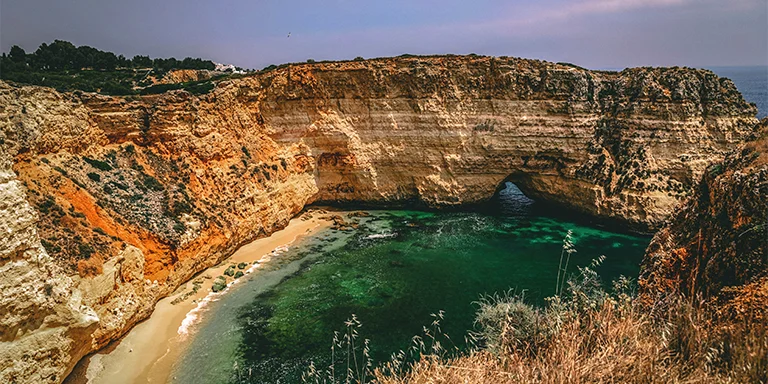
Length: 29.4 mi / 47.3 km
Type: Point to point
Difficulty: Hard
Elevation Gain: 2769 ft / 844 m
Location: Albufeira
Estimated Hiking Calorie Burn: 1500 calories
More Details: See on AllTrails
Conquer the challenging 29.4-mile coastal hike from Albufeira to Portimão in the Algarve region of Portugal. This scenic two-day trek takes around 11 hours and is best done from March through October. Be prepared for incredible cliffside views along the Ecovia do Litoral road. Take care when walking along unbarricaded cliffs and soak in the striking landscapes, beaches, villages, and diverse flora and fauna. Highlights include the charming village of Carvoeiro and the Fort of Ferragudo before reaching Portimão. With its breathtaking coastal scenery, this hike is a must for outdoor enthusiasts visiting the Algarve.
The annual weather for backpacking in mainland Portugal varies, but generally, it experiences a Mediterranean climate:
Before you grab your backpack and head outdoors, take a look at the weather statistics for Portugal (Lisbon):
| Jan | Feb | Mar | Apr | May | Jun | Jul | Aug | Sep | Oct | Nov | Dec | |
|---|---|---|---|---|---|---|---|---|---|---|---|---|
| High °F | 58 | 60 | 65 | 67 | 72 | 78 | 82 | 83 | 79 | 72 | 64 | 59 |
| Low °F | 47 | 48 | 51 | 54 | 57 | 62 | 65 | 65 | 64 | 59 | 53 | 49 |
| Rainy Days | 7 | 6 | 5 | 6 | 5 | 2 | 1 | 1 | 3 | 7 | 8 | 9 |
Not sure if Portugal is right for you?
Don’t forget to check out our backpacking guides for Spain and France.
Lighting campfires while backpacking in Portugal requires extra caution and consideration. Open fires are prohibited in many protected wilderness areas, so research regulations beforehand. Where permitted, choose durable surfaces like sand or gravel, keep fires small, gather only dead & downed wood, maintain safety buffers from vegetation, avoid lighting fires during dry conditions, never leave the fire unattended, fully extinguish embers before leaving, and follow any restrictions on backcountry fire bans.
When you go backpacking in Portugal, make sure to do some research on your route. Pack the right gear, like maps, a compass, a first aid kit, and extra layers. Tell someone where you’re going and when you plan to be back. Stick to the marked trails, be careful on steep slopes and loose rocks, and always have enough water with you. If you’re hiking on the beach, be cautious of strong winds and currents. Know the signs of getting too hot, make sure you’re eating well, and use insect repellent. Keep your valuables hidden, ask park rangers about recent wildlife sightings, and only camp in designated areas. It’s safer to hike with a buddy, check the weather forecast, and consider getting evacuation insurance just in case of an emergency.
For stunning hikes surrounded by nature and mountains beyond mainland Portugal, consider the Azores and Madeira islands. The Azores are known for volcanic peaks, lush forests, waterfalls, crater lakes, and abundant wildlife. Hike through UNESCO-protected laurel forests or up Pico Mountain for incredible views. Madeira’s mountainous interior is covered in levadas providing access to the island’s pristine native laurel forests, cascading waterfalls, and spectacular coastal vistas. The Azores and Madeira both offer incredible hiking opportunities immersed in dramatic natural scenery and mountainous terrain away from mainland Portugal’s crowds.
U.S. citizens do not need a visa to visit Portugal for tourist or business purposes for stays of up to 90 days. With a valid U.S. passport, Americans can enter Portugal and the rest of the Schengen Area visa-free. Just be sure your passport is valid for at least 3 months beyond your planned departure date from Europe.
Porto, Lisbon, Sintra, Lagos, and Coimbra are must-visit destinations for backpacking in Portugal. As a budget traveler, immerse yourself in the history, culture, architecture, and natural beauty across this diverse country. Wander the historic centers of Porto and Lisbon, hike Peneda-Gerês National Park, and experience student life in lively Coimbra. With its walkable cities, stunning coastline, and budget-friendly accommodation, Portugal is an ideal backpacking destination.